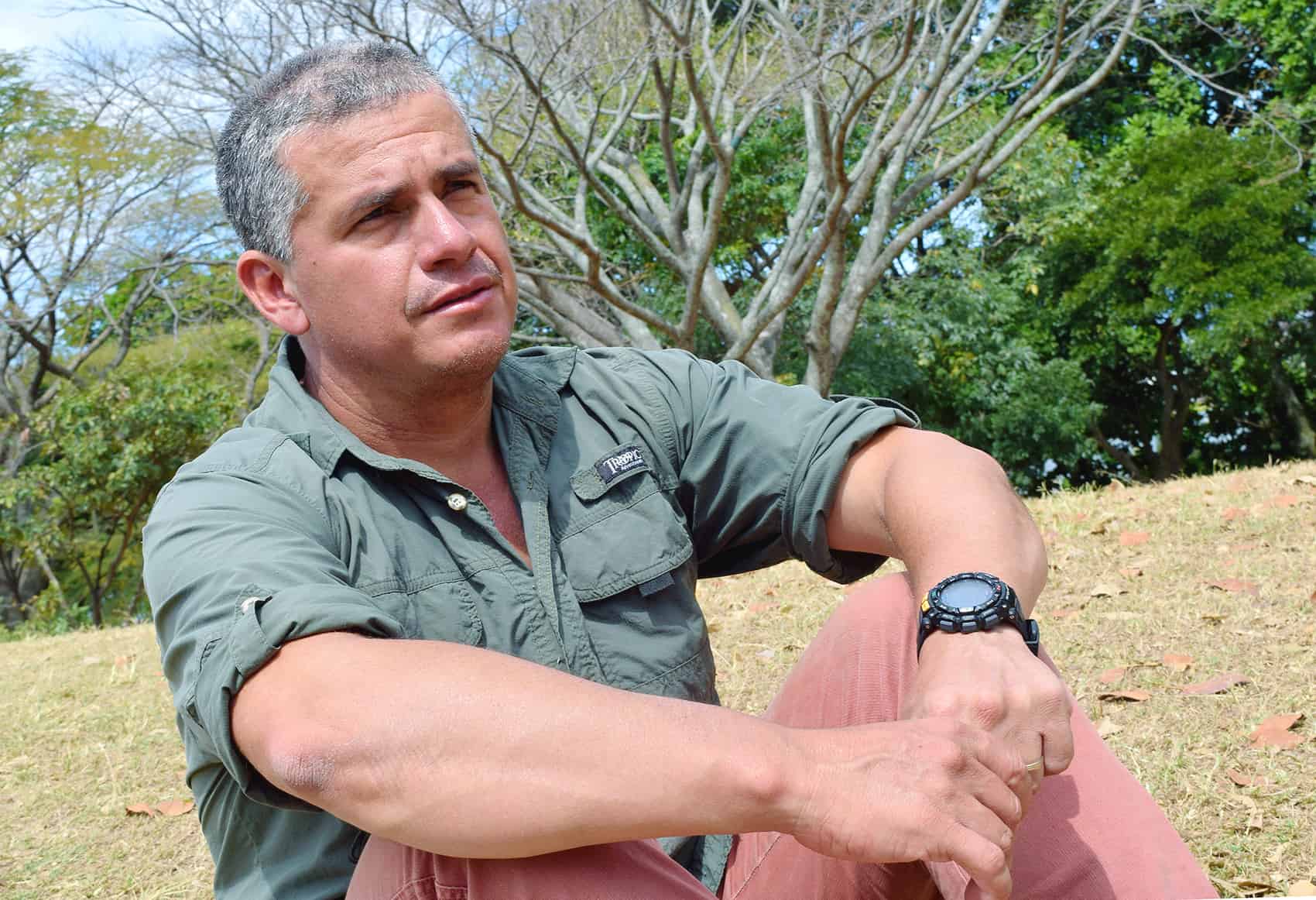Warner Rojas is telling that story again, the one that ends with him standing on top of the world. As he tells it, a small group gathers around with their eyes fixated on him inside a wooden shack atop the cloud-crested village of San Jerónimo, where one-floor houses dot the slopes of the Talamanca foothills like jewels on emerald velvet.
After the sun recedes beyond the towering mountains, light radiates from the open windows wrapping around the shelter where a small projector shows photos of Rojas’ past adventures on a pull-down screen.
Rojas has come to the quiet mountainside pueblo in Cartago province to take part in the next day’s inaugural hike of a new route from San Jerónimo to the base camp of Costa Rica’s tallest peak, Cerro Chirripó. But the only thing the townspeople want to hear about is Mount Everest, which Rojas ascended successfully in May of 2012, becoming the first and only Costa Rican to ever make it to the world’s highest point.
Within seconds of meeting Rojas, a middle-aged man from this coffee-producing town of 500 people asks about the climb to the top. “Everest is what, five kilometers high?” the mustachioed campesino wearing shorts and an oversized polo shirt inquires. “Eight kilometers actually, yes,” Rojas says. The other townspeople laugh and heckle their neighbor for being so far off.
“Warner, being up there at 8,000 meters, my God, how does one do it?” he asks. “Aren’t people always dying up there?” “You’re not always going to die,” Rojas says. “Not if you’re in good condition at least. But if you’re not, you’re going to get the shit beat out of you.” Rojas is practiced at fielding rapid-fire questions from strangers about his Everest climb. He stands unflinching as the gregarious townsman holds out a circled fist towards Rojas’ mouth to mimic a television reporter holding a microphone.
The man wants to know, as do so many others, about the bodies stuck on Everest, including the corpse of one climber on the northeast ridge famous for his neon climbing boots.
“Tell me something,” the man asks. “Did you see that Green Boots dude?” “I didn’t see Green Boots but I did see some other bodies that have been up there for years,” Rojas responds.
“I’m going to go up there and take his boots,” the man says. Laughter echoes around the wooden-walled shelter. “I want one of those boots as a souvenir. I’ll die hanging onto that memento.”
Rojas begins to click through a slideshow of his expeditions throughout the years. The images evolve from the warm, tropical green of La Cruz de Alajuelita, where he took his first climb as a boy, to the stark white of monstrous, snow-covered peaks like Mexico’s Iztaccíhuatl and Argentina’s Aconcagua.
But nothing that Rojas shows his fans grabs their attention like the photos of Tibetan prayer flags lining bridges stretched across mountain passes, yaks carrying supplies up steep slopes, and traditional stone and clay homes in the mountain towns of Nepal. Then Everest appears, which even in pictures, is as intimidating as it is splendid.
At this, the climax of his presentation, he regales his audience with stories of this mountain that he hangs over their heads like myths. When Rojas tells the small crowd how cold it can get on top of Everest – where temperatures can dip down to minus 30 degrees Celsius – they collectively gasp as if watching an especially brutal scene in a horror movie. “Hijuepucha,” they mutter in near unison.
He tells them about being above 8,000 meters, known in the hiking community as the “death zone,” where the body begins to malfunction from the lack of oxygen. During Rojas’ summit, his toes became frostbitten and numb. He tried to kick them against the ground to wake them up, but still he couldn’t feel anything.
“I have an advantage because if I die on the top of Everest, I already don’t feel my toes so I probably won’t feel it in the rest of my body,” Rojas remembers himself thinking as he jokes about it.
The successful ascent solidified his unlikely place in history. Coming from a modest upbringing in a tiny, tropical country where snow is some other-worldly fable, the unschooled kid from Escazú ended up making it to the highest reaches of Earth.
But, as Rojas says, his record conquest was no culmination. Even after reaching the fringes of heaven, Costa Rica’s climber keeps going. “Everest and other mountains are never the end of anything,” he says. “They’re the beginning. There is always more to accomplish.”
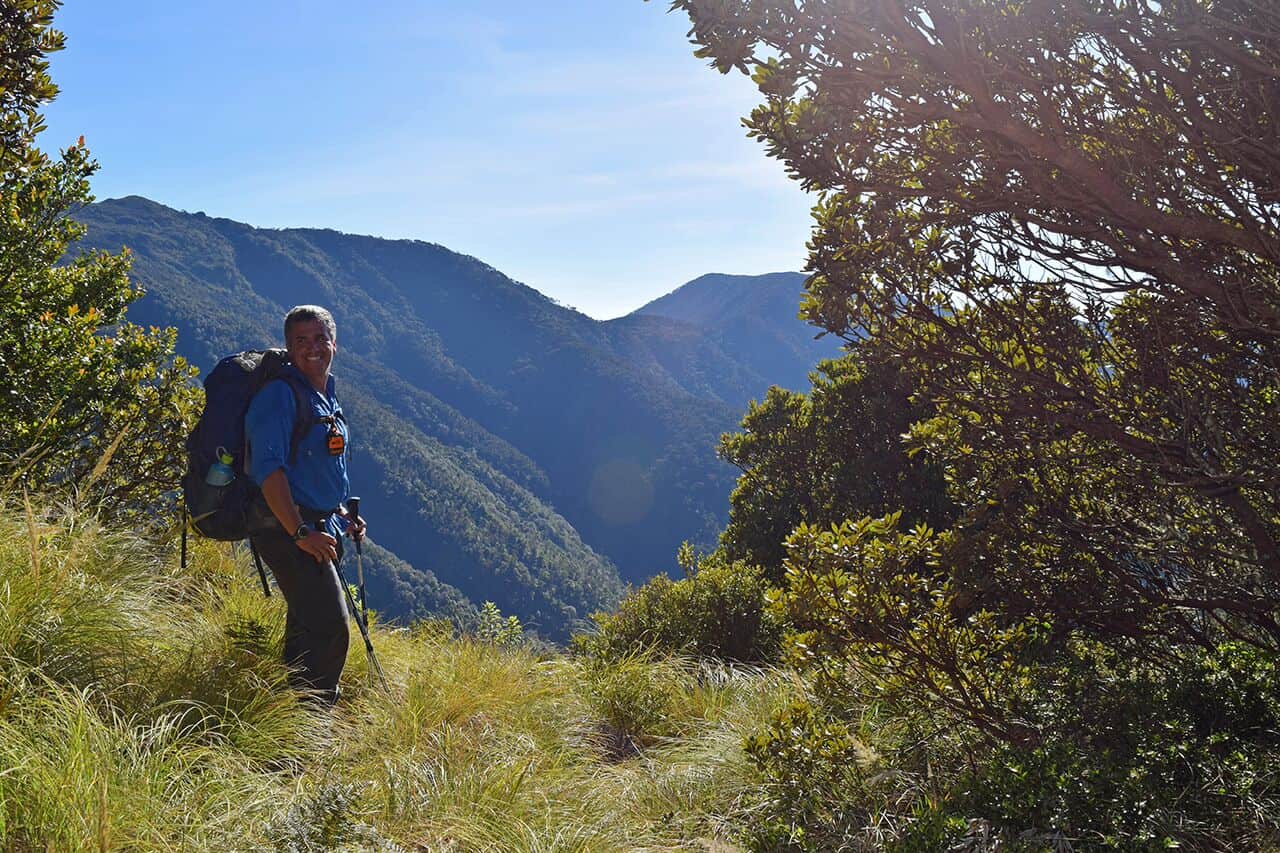
Mapping the course
Before sunrise on the morning after the slideshow, Rojas and seven other hikers began their historic trek up the unmarked trail above San Jerónimo that’s carved into the steep mountainside in the southern part of Chirripó National Park. The group included town tourism association leaders Freddy Quirós and Yamil Jiménez. Both men have lived in San Jerónimo since they were born and have spent decades hiking this exact route long before it opened to the public.
As the sun rose to greet the hikers, Jiménez stayed well ahead of the group. Breaking a silence, Rojas shouted at him from the middle of the pack to get Jiménez to pause and turn around.
“Are you married Yamil?” Rojas inquired.
“Yeah, of course,” Jiménez said.
“You’re so far up there that if we got you two girlfriends and stuck them up there with you, nobody would ever know about it,” Rojas said. Heavy breathing quickly turned to thunderous laughter among the hikers. Jiménez smiled and waved his hand at Rojas before continuing upward.
People tend to hear of the Tico who has conquered some of the world’s most feared peaks before they see him. And when the legend who has etched himself into history appears there in front of you, it is something of a surprise.
Aside from having the thighs of a linebacker, there are few physical clues signaling that this 43-year-old, slightly pot-bellied father of three is an extreme-altitude climber.
He is stout and round from top to bottom. Even his hands and fingers are thick, almost swollen-looking. Their hardened lines bare proof of the years he spent installing ceramic tiles and painting houses as a carpenter with his dad, Jesús. His face, too, is circular though not soft, with traces of stubble surrounding his wide mouth.
His hair, the color of steel wool, is chopped short and even, above his eyes, which are dense and dark, and framed with red. They’re pointed upwards now, as they almost always are, as if to resist a ground that has nothing for them.
Costa Rica’s most famed mountaineer does not know how to drive. He refused to ever learn, thinking it would be too dangerous on San José’s streets.
There is, perhaps, no human on this planet who can eat as quickly as Rojas can. If there were an eating competition between him and a garbage disposal, Rojas would be the betting favorite. While working in construction he had just 10 minutes to eat each day, so he would try to shovel in as much as he could before he had to get back to work.
“From now until we get to the top I’ll be eating,” he said in the car on the way to San Jerónimo right after gulping down a Bavaria Light beer, a Diet Pepsi, and an entire mound of chicken and rice with picadillo in two minutes.
He talks just as rapidly as he eats. Rojas speaks in a low, dominating voice that demands your attention, and he relies heavily on Costa Rican slang, freely and delightedly interjecting “¡diay!” and “huevón” into every sentence he can.
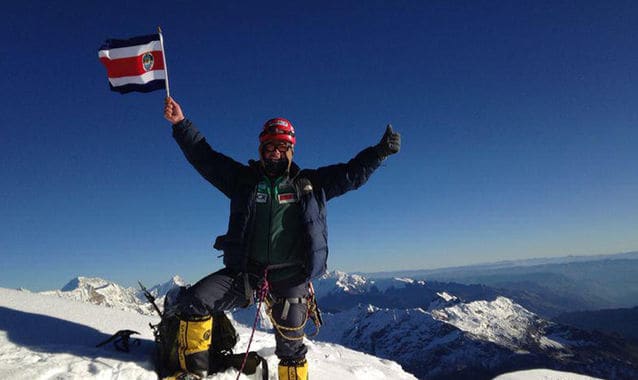
His physical form may be more mule than thoroughbred, more Sancho Panza than Don Quixote. But his mind, much like that of Cervantes’ protagonist, is driven by absurd-sounding quests to satisfy the ego inherent in those who pursue a profession where being the best or the first is looked at as a defining virtue.
Still, Rojas, who is currently attempting to become the first person to hike the world’s 10 tallest volcanoes, says that while ego plays a role in steering him up dangerous peaks, there are also more romantic reasons behind his quest to reach some of the planet’s most inaccessible places.
The dramatic shift in perception a mountain climber gains for his efforts, the ability to rise above whole cities and landscapes as if the views were made just for him, is what Rojas says first fascinated him about hiking.
However, it took time for Rojas to appreciate the mountain. When his father first took him to La Cruz de Alajuelita near the family home in San Antonio de Escazú, a 9-year-old Warner, bored and tired, asked his dad if they could turn around just 10 minutes into the hike.
After that, his father refused to take him on any more hikes. But his mother decided to take the youngster back to the popular Central Valley peak during Easter Holy Week when he was 11. This time Rojas didn’t gripe. And once he finally made it to the top, he didn’t want to leave.
“To see San José from up there is to see another world completely,” Rojas said. “Sometimes one thinks how bad it is for the people to be down there and what luck I have to be up here at this moment instead of in San José with all the noise and everything else.”
After seeing that view, Rojas spurred himself on to hike the rest of the Escazú peaks in his backyard before eventually getting to Chirripó, where he worked as a guide in his early 20s, sometimes summiting the 3,820-meter peak five times in a week.
Before that, he had to work more menial occupations to support his family. Growing up as the oldest with three younger sisters and a mother who stayed home to take care of them, it was up to Rojas to bring in half of the family income. Throughout his teenage years, he worked as a carpenter with his father during the day and went to night classes to get his high school diploma.
“Do you want to keep working or do you want to go to school?” his parents asked one day.
Rojas thought it a silly question. He had to keep working. He had to make sure his family was fed. Then, when his father lost his job, the question became moot and it was up to Rojas to be the sole financial contributor to the home. He was still a teenager.
There was always rice, beans and eggs on the table, but never much else. As a child, Rojas stole bananas from a local farm for his little sisters to eat.
But eventually he left behind his family and friends in Escazú to begin a career in tourism at Chirripó National Park. Rojas never enrolled in college, and has only been on a university campus three times: once to give a speech and twice because he was lost. He likes to say that he’s self-taught and spurred on by a natural will to learn that helped him become obsessed with all things mountaineering.
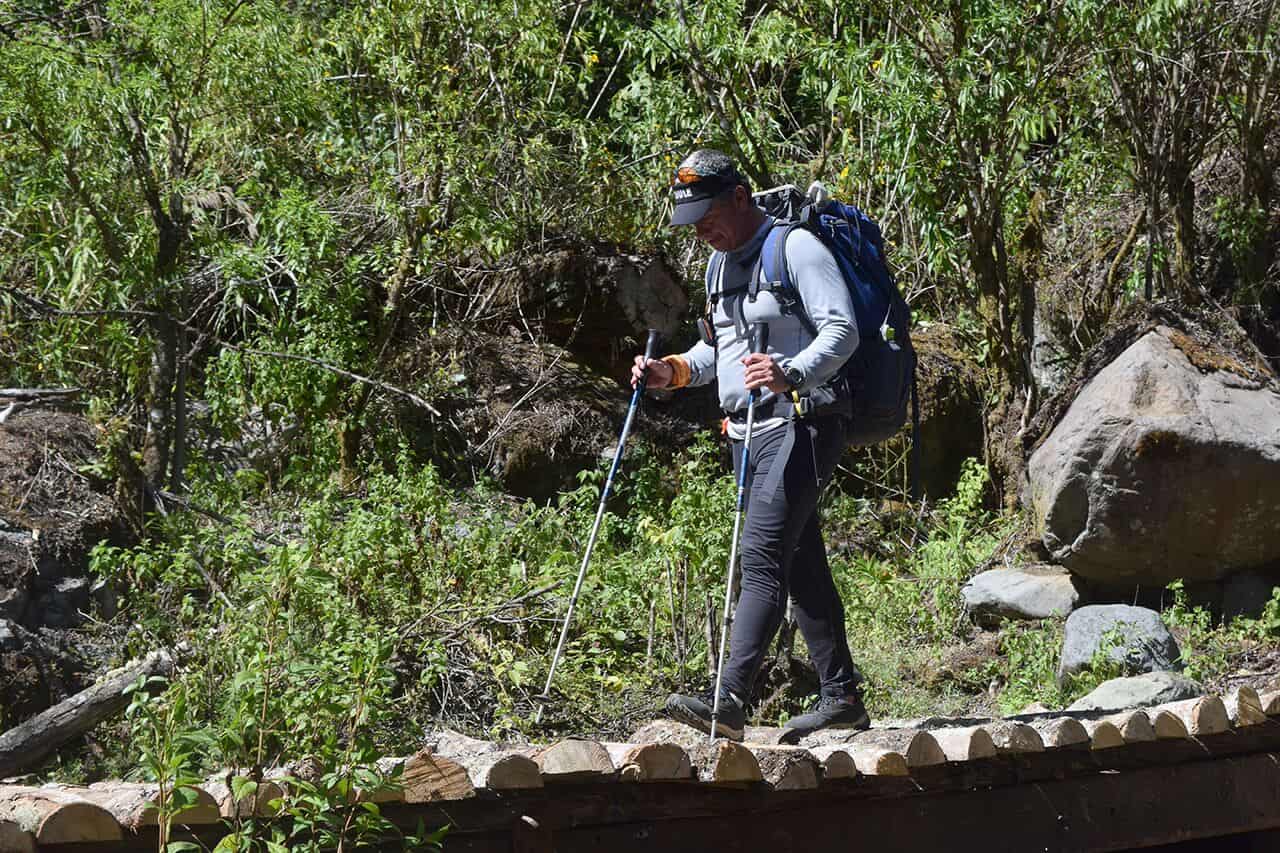
While working on Chirripó he heard travelers’ stories of people climbing peaks so high that they had ice year-round. There were crevices that you had to use ladders to walk over and vertical walls of ice that you had to rappel down.
There were places out there so high up in the air you can see the curve of the earth on the horizon.
He would look out from the Crestones, the dramatic towers of smooth rock above base camp that Rojas says have the best view in all of Chirripó National Park, and see passing clouds make form steps towards the Pacific Ocean.
During his latest climb up Chirripó, a mountain he estimates he’s hiked some 80 times, he takes a second to stop at a lookout point on the mountain’s edge and scan over it with his phone to take a video. When one of the hikers in his group asks Rojas if he ever gets tired of these views, he shakes his head and barely says anything at all.
It’s a rare feat to find the normally talkative Rojas without words. While a cascade of light drowns the V-shaped valley beyond him, making the green shine like crystal, it becomes clear there’s not much to say in a place like this.
Spurts of wind sing through hanging leaves. Clouds crash silently into the humps of the Talamanca. Birds of prey streak through the ample blue backdrop.
All of it combines into a larger feeling reminiscent of the one Rojas found on La Cruz de Alajuelita all those years go.
“Call it God, Jesus, Buddha, or whatever you want to call it, I think a higher spirit exists and that it’s so fundamental for humans to believe in something,” he said later. “One has to live for some sort of spirituality and the spirit I live for resides in the mountain.”
Acclimation
The idea itself is surreal. A man from a tiny, tropical country who wants to climb mountains of ice and snow? Not only are such things foreign to most Costa Ricans, they’re happily avoided. It would take a madman to come from here and seek out the bitter cold.
Rojas says he was 23 when he first came across ice. On the summit of Pico Orizaba, the tallest peak in Mexico, he completed one of his first technical hikes where more advanced equipment like ropes and crampons were required. There, the tall tales he heard on Chirripó came to life.
“You can’t imagine the fear for me first arriving at these specialized peaks covered in ice,” Rojas said. “It was like walking over egg shells that you always felt were going to break.” Yet he fell in love with that sensation. He told himself at the top of the 5,600-meter peak that this is what he would dedicate his life to.
He came down from the mountain, fully aware that what he wanted to do was abnormal but determined to set out on this new career path. “It was a little weird to do this in Costa Rica, because you know, who hikes mountains for a living?” he said. “Especially mountains with ice.”
When he told his parents of his newfound profession they were mortified. “What kind of vagrancy is that?” they said. They told him instead he needed to take the office job that had already been set up for him.
Rojas, though, was certain that climbing mountains was what he was meant to do. He struck a deal with his parents that if he couldn’t find a concrete way to make money with it in six months, then he would go back to working in an office.
He set out on his first major mountaineering project: summiting the highest points of the Andes mountains in each of the seven South American countries the chain runs through.
At first Rojas didn’t know how he was going to get to these peaks until someone told him he had to get sponsors to pay for his expeditions. When he secured a meeting with one potential sponsor in Costa Rica, he had to fill out a form describing what the project was and how it could benefit the company.
After he gave the form back and one of the company heads had time to look over it, he came back to Rojas and said, “Sir, what is all this crazy talk about going up mountains? Here we play football.”
Rojas realized getting to these mountains was going to require more struggle than the climbs themselves. He was faced with his first conflict as a young mountaineer, a profession riddled with a nagging dilemma: should one continue ahead and possibly risk one’s life or turn around and safely make it back home.
“You know you can always have a stable job that generates some constant income, or you can have something where you’re always looking for ways to get money,” he said. “I knew that it was risking a lot. But maybe part of me has always liked to bite off more than I could chew.”
Rojas said he did a million things to scrape up enough money to start his expedition up the tallest peaks in South America. Along the way he became more fluent in the aspects of technical climbing and learned some tricks for climbing at extreme altitude, generally considered any point above 5,500 meters (18,000 feet).
On a climb in Mexico, Rojas’ water bottle froze because he had it right-side up in his backpack. Generally climbers are taught to put their water upside down because water freezes from top to bottom. Rojas had to go the entire day, a grueling nine-hour hike, without water.
“I never used to ask questions because any evidence that someone knew more than I did made me ashamed,” he said. “Never again will I not ask about something I don’t know. You can only learn by asking.”
Rojas’ Andean project ended in 2011 when he successfully made it to the summit of Peru’s Huascarán, his last remaining peak of the region’s seven highest, and also one of the most dangerous. On a return visit to the mountain in 2014, Rojas and his Peruvian hiking partner were almost killed above 6,000 meters when a wall of ice broke off and ran down a part of the mountain where they were hiking just five minutes prior.
He told local press at the time it was a miracle they were still alive. They decided to come down from the mountain because there had been a number of other avalanches during their ascent.
“It was a hard decision but good judgment prevails,” he told the Spanish-speaking newspaper Al Día upon the hike’s conclusion. “Making good decisions is something that has characterized me as a mountaineer.”
If great basketball players are regarded by how many points they score and great runners noted for how many records they break, it’s easy to assume that professional climbers should be judged on their number of successful high-altitude summits. But the difference between a good hiker and a great hiker, Rojas said, is his ability to know when to step back — even if the summit is in sight.
“Being a great mountaineer isn’t just about making it to the summit,” he said. “It’s being able to come back to tell the story.”
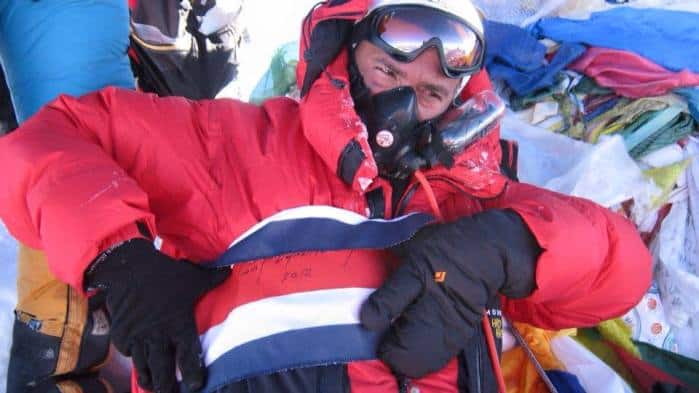
The Death Zone
Death is everywhere on her peak. It’s in that white wind known as the jet stream that shoots itself past the jagged heads. The sound of cracking from ice walls and avalanches that roll down her sides proves it near. Nowhere is it more visible than in the corpses that litter her landscape of snow and rock.
Some 200 bodies are believed to lay near the top of Everest. There are those who have been long dead and are now mummies preserved by the extreme altitude and cold, their faces turned black from intense frostbite and slow decay. And there are others, who have died on the mountain within the past few years, who remain in almost perfect form and look as if they were alive but sleeping.
Eleven people died on Everest in the three months that Rojas was there in mid-2012, when an unprecedented log-jam of climbers looked for opportune breaks in bad weather. A few died from falls. More died from exhaustion, laying down in the oxygen-deprived death zone to take a quick rest and never getting back up again, ending up seared into the mountain for what could be eternity.
When Rojas was between base camp and the top, more than 100 climbers rushed to scale Everest on the last weekend of the climbing season. The mountain is generally only summited four months out of the year, from April to May and September to October, because during those times the jet stream winds die down enough to not pick a climber off the mountain.
Rojas walked past the body of one hiker, Canadian Shriya Shah-Klorfine, who had died of exhaustion just five days before near a section located at 8,300 meters known as “The Balcony.”
Some climbers have said that first seeing the bodies on Everest can be overwhelming, almost like looking into a mirror and seeing your own fate in front of you, while others walk by as if the bodies aren’t there at all.
“When I pass them they are mannequins,” Rojas said. “I don’t feel anything. They’re mannequins. Unfortunately they died, but I can’t do anything for them.”
That may seem a harsh view on a sad reality. But in a sport where one’s ego can act as a siren call, luring you to the top even when your mind has gone delusional from altitude sickness or exhaustion, the most valuable trait one can have is to keep a clear wit.
“Usually it’s because of bad decisions that they’re dead,” Rojas said. “I have to do things well and make good decisions to not end up like them. It’s a decision. The line is that thin. It’s the line between continuing and going back.”
But for Rojas, a hike past these bodies clad forever in full hiking gear on the accidental cemetery of Everest isn’t his closest confrontation with death. In a sense, he was made for this kind of environment, where one must have a detached emotion towards death.
When he was 19, Rojas held his dying grandmother in his arms while a heart attack took her life. He was the first one there, trying but failing to resuscitate her. Nearly 15 years later, his father died in exactly the same way at the family home. His mother and niece were alerted to Jesús’ sudden and surprising death when they heard Rojas crying over his father’s body.
“Things happen for a reason,” he said. “After I’ve had people I loved literally die in my arms – yeah of course it bothers me to see dead bodies – but sentimentally I have no connection with those people.”
Now every time Rojas sets off for a difficult hike, he tells his wife and their three kids that he will return home. It’s a promise he makes not only to them, but to himself. It’s a reminder that even at extreme altitudes, where rational thinking is bent and distorted without the oxygen it needs, he’ll make the right decision.
After passing Shah-Klorfine’s body during his summit attempt, he stopped to check on himself. Apart from the totally numbed toes, he felt fine. He was rationalizing well, he spoke to his Sherpa in English, and understood when his Sherpa responded in English. “I’m making it to the top,” he told himself.
He reached the summit around 7 a.m. Nepalese time on May 24, 2012.
When he made it back to Camp 3, his toes started to come back to life. At base camp, he noticed a black scar from frostbite on the big toe of his left foot.
Everest left a small but permanent mark on Rojas. And for that, he’s lucky.
“It’s clear that she decides if you’re going to go up or not,” he said of Everest. “You have to ask permission from the mountain’s spirit and not disrespect her. She’s the one in command.”
When he left Costa Rica for Nepal, Rojas was just some climber. But when he came back, having conquered Everest, he was Costa Rica’s climber. People called it the greatest sporting achievement by anyone in the history of the country. He was treated to public ceremonies with then President Laura Chinchilla and introduced as the main story on every local news station.
Back at the Crestones base camp in Chirripó, he is still a local celebrity.
Costa Ricans who recognized him during his recent stay there asked him to pose for pictures with a backdrop of the iconic Crestones rock formations. When others sitting in the dining room saw him outside being requested for pictures, they whispered to inquire who he was.
“That’s Warner Rojas?”
They, too, then ran over and asked him for photos. Rojas, always calm and jovial, abided every request and made fluid small talk.
He’s at home here, in the heart of the Talamancas, where as a guide he has memories of having to motivate slower hikers, sometimes taking 13 hours to get them up from the main entry of San Gerardo, a route that he can routinely do in half that time.
Yet ironically, he didn’t make it to the top of Cerro Chirripó on his most recent hike. Before the team took off at 4 a.m. for the two-hour climb from base camp to the top, Rojas woke up and said his stomach didn’t feel right and that he was going back to bed.
The team set out for the peak without him, under rain clouds and bitterly cold winds. Just before the steep, rocky climb to the peak, they came upon a couple. The woman was huddled over and visibly ill. She had been sick the night before but wanted to try and summit anyway. She and her boyfriend didn’t make it to the top, but luckily made it safely back to base camp.
The group continued to the top, where thick clouds waved above the wooden sign with the words “Cerro Chirripó” painted in yellow. The hikers paused for a few minutes of photos before turning for the slippery hike back down.
When they got back to base camp, Rojas was relaxing with a cup of coffee. He joked with them that he could see the rain clouds pounding them on their way up the peak and that it really was better he stayed back.
Though it’s not even half the size of Everest, Chirripó, too, has claimed lives. Some have outright vanished on her slopes.
As Rojas says, it is the mountain that a climber must be in total accord with, or else stay back from her crown. It is the mountain that has the power to turn one into either a legend or a ghost.
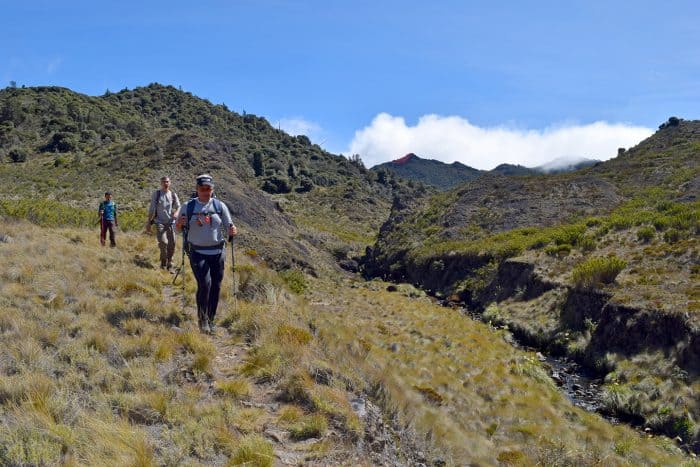
False summit
There is an enduring image of Rojas reclined atop Everest stretching a Costa Rican flag over his chest. His face is burnt to a purplish char between the oxygen mask over his mouth and the goggles that reflect the gold-tinted Himalayas and the shining circle of the earth. His squinted, reddened eyes are shifted towards the left to fight off the wind throwing up specks of ice.
Other athletes, like the Costa Rican sports figures who have risen to the ranks of the best football clubs in the world or the top international surf tournaments, are immortalized by television highlights and professional photography. Football star Bryan Ruíz has the memorable shot of himself spreading his long arms with his mouth agape after scoring the game-winning goal against Italy in the 2014 World Cup. Real Madrid goalkeeper Keylor Navas, maybe the country’s most recognizable citizen, has the now-famous photo of him pointing his index finger to the heavens after making a spectacular penalty kick save for his club.
These are their entries into immortality, their highest achievements forever enshrined into the annals of Costa Rican sports lore.
In Rojas’ picture, while at the literal pinnacle of his profession, he does not just look battered or sweaty, like many athletes do in their iconic shots. He looks nearly dead. The only sign of life in him, what separates him from the bodies frozen into Everest, are the eyes directed outward at the bending horizon. They peer into another world, onto a landscape that no other Costa Rican has ever managed to see.
Still the question from the masses rings like an ache in the ear of the mountain climber: Why do this? Why put your life at risk for so little recognition or money? The doubts of the company man denying sponsorship echo. What kind of madness is this? We play football here.
“People watching football, what they see is Bryan Ruíz, Keylor Navas, who have become these powerful figures that everyone recognizes,” Rojas said. “Mountaineering doesn’t offer that. But if you’re the first to summit Everest, there’s no one in football who can top that.”
British explorer George Mallory, who took part in the first recorded attempts to reach Everest’s summit and whose lifeless body became one of the first to accumulate near the peak when he died there in 1924, once said there was no practical use at all in climbing Everest. It was not to excavate gold or coal or provide any other societal gain.
“If you cannot understand that there is something in man which responds to the challenge of this mountain and goes out to meet it, that the struggle is the struggle of life itself going upward and forever upward, then you won’t see why we go,” he said.
This line between life and death, between achievement and dissatisfaction is blurred invisible by the wind and the ice on Everest.
“I’m doing this because it’s my passion and maybe it doesn’t generate much money, but I always decided to go by what moves me from inside,” Rojas said.
In March he will set out for another climb. Rojas and Guatemalan climbing partner Jaime Viñals, the first Central American to climb Everest, are trying to become the first people to hike the world’s 10 tallest volcanoes. They will attempt to summit Argentina’s Llullaillaco, the planet’s second largest volcano, which would be the sixth checked off their list.
Despite Rojas’ continued drive for firsts in mountaineering, he admits that achieving such goals amounts to little more than an ego boost. He says the real rewarding part of his profession is giving back to mountaineering by literally blazing new trails.
In a place like Llullaillaco, which became the highest archaeological site ever when the mummies of three children from a 500-year-old Incan sacrifice were found in 1999, mountaineering is in large part exploration. The isolated volcano is rarely climbed. It also remains dotted with land mines from Chile and Argentina’s border war in the 1970s and 80s.
Unlike Chirripó, or even Everest, many of the volcanoes that Rojas and Viñals will climb don’t have clear trails or defined paths to the top, meaning the pair could be mapping out new routes for others to follow.
“That, for me, is what makes a project like this worthy: marking routes and making differences so that other people can go to these places, too,” he said. “We’re able to contribute to mountaineering by doing things that have never been done before.”
Rojas also has a standing invitation to climb the notorious K2, one of the deadliest mountains in the world. The second tallest peak, which Rojas refers to as “a beast,” is known in the mountaineering community to be a considerably more difficult climb than Everest. Years can go by without anyone reaching its summit. One in every four people who try to tame the menacingly vertical peak dies. Yet Rojas says he’ll go to K2 or another 8,000-meter peak if he feels fine after his volcano project.
Rojas considers the demand of mountaineering to be 70 percent mental and 30 percent physical. “It’s being able to stand failure, to stand hunger, to stand being hundreds of kilometers away from your family,” he said.
When he nears a peak or comes across a difficult stretch, the man who spends much of his time giving motivational speeches throughout the country says he finds himself thinking of other inspirational Costa Ricans, like astronaut Franklin Chang or the record-breaking Special Olympics athletes. He also thinks of his family.
“I always have to think positively because my objective isn’t just to arrive at the peak,” he said. “My objective is to come back home safe and sound.” When he’s at home with his family in San Antonio de Escazú, he still summits La Cruz de Alajuelita to train. It always pulls him back.
He runs up the route nicknamed “chest breaker” that goes off the main trail and leads through forest and uncut grass. At the top, there is the rusted steel cross that marks the genesis of his boyhood desire to stay forever above the chaos of the city. “It’s a heavy wind that blows up there,” he said.
Below the rim of mountains lie the red and white smatterings of the city. Tiny-looking cars drive around the Circunvalación highway that rings the city, moving slow and silent. A vulture lets itself be taken by a gust of air as it hovers above the city.
On the other side, the Escazú range runs southeast, pointing towards the Talamancas. There is no noise but the wind, which pushes forever forward.
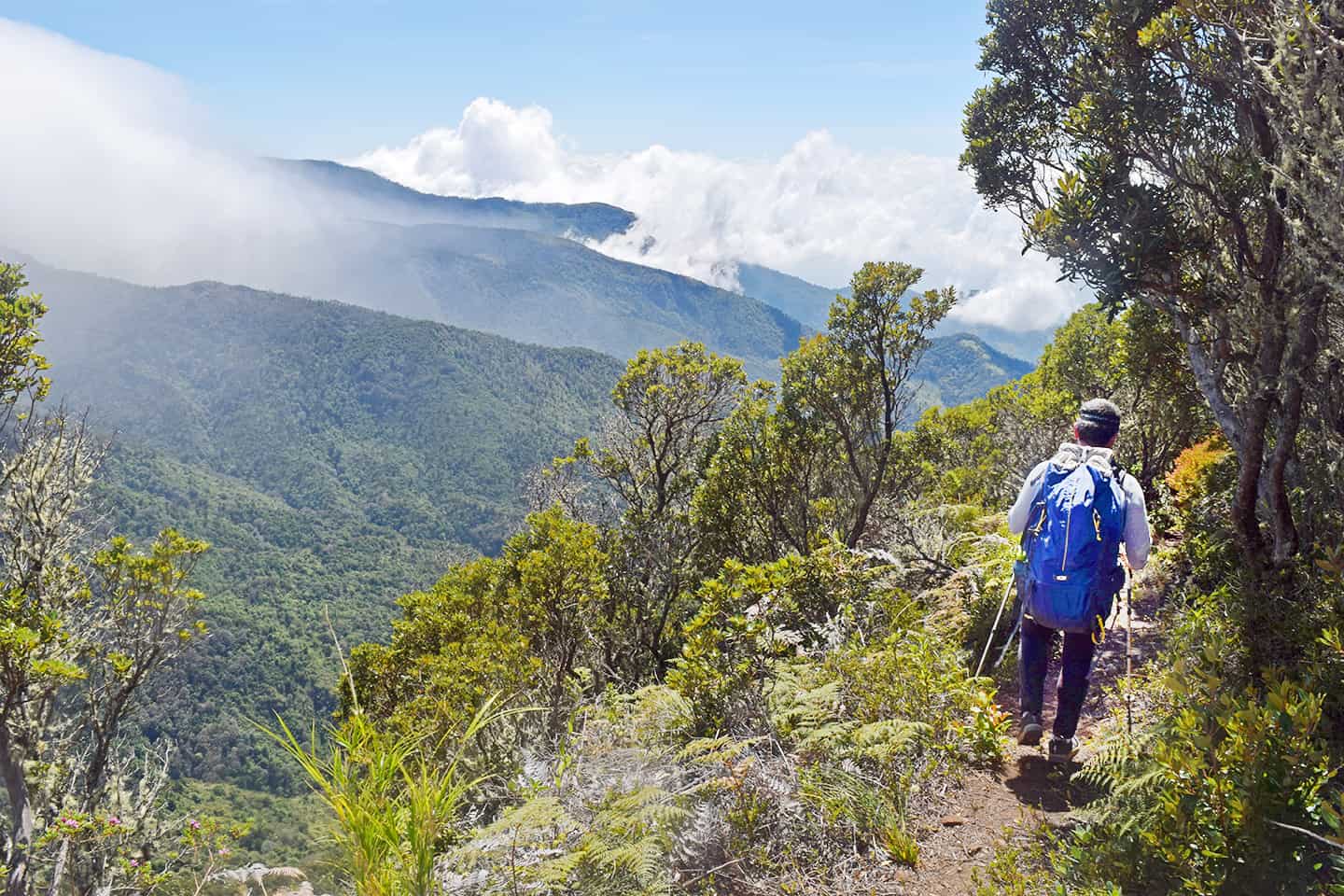
Back to base
Rojas disappeared into the brush as he sprinted down Chirripó towards San Jerónimo. Dead leaves sprung up by his boots as they crashed and rose, over and over, beating a symphony into the soil. Appearing again, he swung himself through a window of trees and jumped over a fallen branch.
Rojas and company made it back to La Chakra tent camp and the trailhead at midday, ending the inaugural hike up Chirripó’s newest official route.
The immortal call to action, to climb and descend, provides an endless string of challenges for the climber looking to make his or her name. For Rojas, the places to which he’s journeyed do not just mark points of origin and epiphany, but clear progressions that make an arrow pointing towards the sky.
La Cruz de Alajuelita. Cerro Chirripó. Pico Orizaba. Mount Everest. They were all steps, each one higher and more difficult than the previous. They were doors, too, peaking into heavenly corridors that change the eyes of those who view them.
“Going to the mountain gave me another vision of life,” he said. “You realize that there is no singular truth but rather a whole spectrum of shades to see.”
After eating four plates of spaghetti and gallo pinto for lunch in a matter of minutes in the open-walled refuge at La Chakra, Rojas laid on his back on the pale wooden floorboard in the shelter’s corner.
Beyond him to either side, vertical waves of mountains reached so high above his frame that they toyed with perspective. Green and red and mighty. The midday light washed them clean of any trace of shadow.
The sun will fall from its apex before rising again, and the climber will step towards it as it beckons to him and tempts him to come just a little bit closer.
“You see the world in a different way and see that there are so many places you can reach,” Rojas said. “You know that when you’re perched on top of those places that it’s not the end, but the beginning.”

